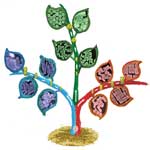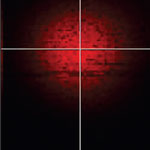Showing Spotlights 177 - 184 of 213 in category All (newest first):
 Nanotechnologies are opening vast new opportunities for scientists, engineers and entrepreneurs to participate in solving some of the major problems facing mankind today. But the road from idea to commercially viable product or process is long. Especially when it comes to nanotech innovations, the research and development phase tends to be relatively lengthy. To help potential nanotechnology start-up founders with shaping their plans, Nanowerk, the leading nanotechnology information service, and Nanostart, the world's leading nanotechnology venture capital company, have teamed up to provide this useful guide which particularly addresses the funding aspects of nanotechnology start-ups, along with answers to some of the most commonly asked questions.
Nanotechnologies are opening vast new opportunities for scientists, engineers and entrepreneurs to participate in solving some of the major problems facing mankind today. But the road from idea to commercially viable product or process is long. Especially when it comes to nanotech innovations, the research and development phase tends to be relatively lengthy. To help potential nanotechnology start-up founders with shaping their plans, Nanowerk, the leading nanotechnology information service, and Nanostart, the world's leading nanotechnology venture capital company, have teamed up to provide this useful guide which particularly addresses the funding aspects of nanotechnology start-ups, along with answers to some of the most commonly asked questions.
Oct 21st, 2009
 Here is the book you all have been waiting for: Nano-Society - Pushing the boundaries of technology. Written by Nanowerk's Michael Berger, this book puts a spotlight on some of the scientists who are pushing the boundaries of technology and it gives examples of their work and how they are advancing knowledge one little step at a time. Nano-Society is the latest addition to RSC Publishing's Nanoscience and Nanotechnology series. Edited by Sir Harry Kroto, Paul O'Brien, and Harold Craighead, the series provides a comprehensive source of information on research associated with nanostructured materials and miniaturized lab-on-a-chip technologies. The book covers 122 very specific research projects that are happening in laboratories around the world and provides commentaries from the scientists in their own words.
Here is the book you all have been waiting for: Nano-Society - Pushing the boundaries of technology. Written by Nanowerk's Michael Berger, this book puts a spotlight on some of the scientists who are pushing the boundaries of technology and it gives examples of their work and how they are advancing knowledge one little step at a time. Nano-Society is the latest addition to RSC Publishing's Nanoscience and Nanotechnology series. Edited by Sir Harry Kroto, Paul O'Brien, and Harold Craighead, the series provides a comprehensive source of information on research associated with nanostructured materials and miniaturized lab-on-a-chip technologies. The book covers 122 very specific research projects that are happening in laboratories around the world and provides commentaries from the scientists in their own words.
Sep 28th, 2009
 Sand. Shrubs. Burst tires. More sand. The last thing you would expect as you drive along the Red Sea near Mecca is to encounter an ultramodern science city. Yet there it is. Appearing after an 80 kilometer drive from Jeddah, Saudi Arabia's second-largest city, the 36 square kilometer campus of King Abdullah University for Science and Technology (KAUST) appears like a Fata Morgana out of the desert sand. Yesterday, September 23rd, King Abdullah of Saudi Arabia officially opened the country's most modern and ambitious university near the old fishing village of Thuwal. Nanowerk was invited to attend the spectacular opening ceremony. Much more than a future elite university, the vision behind KAUST is to create the nucleus of a modern society, free from the strict religious dictates of a conservative Islamic culture, and laying the foundation for a science and technology based society of future generations.
Sand. Shrubs. Burst tires. More sand. The last thing you would expect as you drive along the Red Sea near Mecca is to encounter an ultramodern science city. Yet there it is. Appearing after an 80 kilometer drive from Jeddah, Saudi Arabia's second-largest city, the 36 square kilometer campus of King Abdullah University for Science and Technology (KAUST) appears like a Fata Morgana out of the desert sand. Yesterday, September 23rd, King Abdullah of Saudi Arabia officially opened the country's most modern and ambitious university near the old fishing village of Thuwal. Nanowerk was invited to attend the spectacular opening ceremony. Much more than a future elite university, the vision behind KAUST is to create the nucleus of a modern society, free from the strict religious dictates of a conservative Islamic culture, and laying the foundation for a science and technology based society of future generations.
Sep 24th, 2009
 Sometimes we get bombarded with emails from people who are new to the field about certain aspects of nanotechnology - can it cure cancer? Where can I buy nanobots? What is a nanomaterial? Is nanotechnology dangerous? And so forth. You get the idea. The question asked most often is simply this: 'What is nanotechnology?' That's why we have decided to add a new segment to our Nanowerk website that we call 'Ten things you should know about nanotechnology'. What we have been trying to do here is to provide a brief overview of some important aspects and issues and answer some of the basic questions on nanotechnologies. Of course, there is lots of important information that we omitted. But we feel that, if you are new to nanotechnology, this is a good point to start.
Sometimes we get bombarded with emails from people who are new to the field about certain aspects of nanotechnology - can it cure cancer? Where can I buy nanobots? What is a nanomaterial? Is nanotechnology dangerous? And so forth. You get the idea. The question asked most often is simply this: 'What is nanotechnology?' That's why we have decided to add a new segment to our Nanowerk website that we call 'Ten things you should know about nanotechnology'. What we have been trying to do here is to provide a brief overview of some important aspects and issues and answer some of the basic questions on nanotechnologies. Of course, there is lots of important information that we omitted. But we feel that, if you are new to nanotechnology, this is a good point to start.
Aug 20th, 2009
 Many of the properties of a given nanoparticle not only depend on its chemical composition but also on its size and shape, i.e. its morphology. These morphological factors have significant impact on a nanoparticle's optical and catalytic properties. Accordingly, nanoparticle manufacturers have developed numerous 'recipes' for synthesizing particles with desired size and shape. To facilitate systematic investigation on the morphology-property relationship, it would be highly desirable if one reaction system can be engineered to yield as many different shapes as possible with minimal degree of parameter tuning. To that end, researchers proposed a way to systematically engineer the morphologies of nanoparticles by constructing an evolutionary tree, which consists of several pathways, each showing a 'string' of evolving shapes over the courses of a single reaction. The tree not only displays the relationship between different shapes, but also offers designing principles for producing more complex shapes by crossing over different pathways during nanoparticle growth.
Many of the properties of a given nanoparticle not only depend on its chemical composition but also on its size and shape, i.e. its morphology. These morphological factors have significant impact on a nanoparticle's optical and catalytic properties. Accordingly, nanoparticle manufacturers have developed numerous 'recipes' for synthesizing particles with desired size and shape. To facilitate systematic investigation on the morphology-property relationship, it would be highly desirable if one reaction system can be engineered to yield as many different shapes as possible with minimal degree of parameter tuning. To that end, researchers proposed a way to systematically engineer the morphologies of nanoparticles by constructing an evolutionary tree, which consists of several pathways, each showing a 'string' of evolving shapes over the courses of a single reaction. The tree not only displays the relationship between different shapes, but also offers designing principles for producing more complex shapes by crossing over different pathways during nanoparticle growth.
Jul 29th, 2009
 In a recent Nanowerk Spotlight we reported on a single molecule approach to directly visualize and map protein binding sites on DNA using fluorescent quantum dots. One of the challenges the researchers in this work had was to measure distances between probes bound to combed DNA with nanometer resolution. Whereas very short distance (below 10 nm) can be assessed by FRET measurements and distances above the Rayleigh criterion can be measured, say, with a standard microscopy picture and a ruler, distances in between need to be addressed differently. This is were a novel approach by scientists at UCLA fills the gap, and, as they claim, better than other techniques do.
In a recent Nanowerk Spotlight we reported on a single molecule approach to directly visualize and map protein binding sites on DNA using fluorescent quantum dots. One of the challenges the researchers in this work had was to measure distances between probes bound to combed DNA with nanometer resolution. Whereas very short distance (below 10 nm) can be assessed by FRET measurements and distances above the Rayleigh criterion can be measured, say, with a standard microscopy picture and a ruler, distances in between need to be addressed differently. This is were a novel approach by scientists at UCLA fills the gap, and, as they claim, better than other techniques do.
May 27th, 2009
 A recent study has shown that nineteenth century thermodynamics can still provide useful insights into twenty-first century nanosciences; and all this can be done with pencil and paper rather than an expensive super-computer! When the size of materials approaches the nanoscale, matter begins to behave highly exotically. By shrinking the size of materials, the surface-to-volume ratio increases. Considering this, scientists can study size effects on material properties from macroscopic laws, the so-called top-down approach. In thermodynamics, the Gibb's energy concept is particularly suited to describe the liquid-solid phase transition (what we mortals call the melting temperature).
A recent study has shown that nineteenth century thermodynamics can still provide useful insights into twenty-first century nanosciences; and all this can be done with pencil and paper rather than an expensive super-computer! When the size of materials approaches the nanoscale, matter begins to behave highly exotically. By shrinking the size of materials, the surface-to-volume ratio increases. Considering this, scientists can study size effects on material properties from macroscopic laws, the so-called top-down approach. In thermodynamics, the Gibb's energy concept is particularly suited to describe the liquid-solid phase transition (what we mortals call the melting temperature).
Apr 17th, 2009
 Not surprisingly, it has been scientists in The Netherlands - a country that has long been conducting large-scale and long-term field studies on the benefits of certain plants to mental and physical health (scientists refer to this effort as the 'great coffee house smoke screen studies') - that have come up with a nanotechnology discovery that could well revolutionize many consumer products from food to toys. In a report released today, April 1, the Dutch scientists report that a nanoparticulate substance found in Cannabis sativa, also know as marijuana, has an amazing ability to kill fat cells in the human body. Hoping to ride an early wave of commercialization, the Dutch research group has already filed for patent protection and registered the trademark 'Royal Spliffmeister Edition' for a range of planned products.
Not surprisingly, it has been scientists in The Netherlands - a country that has long been conducting large-scale and long-term field studies on the benefits of certain plants to mental and physical health (scientists refer to this effort as the 'great coffee house smoke screen studies') - that have come up with a nanotechnology discovery that could well revolutionize many consumer products from food to toys. In a report released today, April 1, the Dutch scientists report that a nanoparticulate substance found in Cannabis sativa, also know as marijuana, has an amazing ability to kill fat cells in the human body. Hoping to ride an early wave of commercialization, the Dutch research group has already filed for patent protection and registered the trademark 'Royal Spliffmeister Edition' for a range of planned products.
Apr 1st, 2009
 Nanotechnologies are opening vast new opportunities for scientists, engineers and entrepreneurs to participate in solving some of the major problems facing mankind today. But the road from idea to commercially viable product or process is long. Especially when it comes to nanotech innovations, the research and development phase tends to be relatively lengthy. To help potential nanotechnology start-up founders with shaping their plans, Nanowerk, the leading nanotechnology information service, and Nanostart, the world's leading nanotechnology venture capital company, have teamed up to provide this useful guide which particularly addresses the funding aspects of nanotechnology start-ups, along with answers to some of the most commonly asked questions.
Nanotechnologies are opening vast new opportunities for scientists, engineers and entrepreneurs to participate in solving some of the major problems facing mankind today. But the road from idea to commercially viable product or process is long. Especially when it comes to nanotech innovations, the research and development phase tends to be relatively lengthy. To help potential nanotechnology start-up founders with shaping their plans, Nanowerk, the leading nanotechnology information service, and Nanostart, the world's leading nanotechnology venture capital company, have teamed up to provide this useful guide which particularly addresses the funding aspects of nanotechnology start-ups, along with answers to some of the most commonly asked questions.
 Subscribe to our Nanotechnology Spotlight feed
Subscribe to our Nanotechnology Spotlight feed





